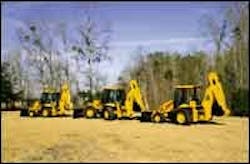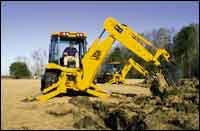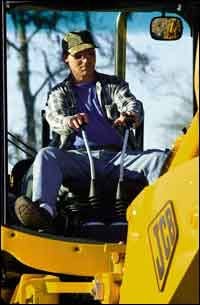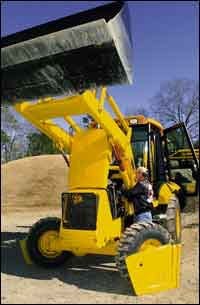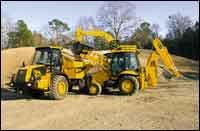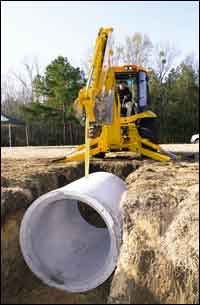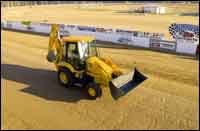JCB Pushes the Right Design Buttons
In March of last year, at Conexpo-Con/Agg 2002, JCB unveiled its New Generation backhoe-loaders—literally. The new machines sat shrouded under an immense canopy of parachute silk during the early hours of the show. Then, when the moment for unveiling arrived, a powerful air winch in the center of the JCB display whisked off the wraps in the blink of eye. An impressive sight it was. But, says JCB, the new backhoes represent one of the company's most important product launches in a decade. So who can begrudge a little showmanship?
When Construction Equipment editors visited the JCB folks at their Pooler, Ga. (near Savannah), headquarters a couple of months ago, we found them just as enthusiastic about the new backhoe-loader line as at the big show in Las Vegas. We were there to work with them in evaluating the most popular model in the New Generation line, the 214, against its predecessor, the 214 Series-3.
JCB has slightly more than 1,000 acres in Pooler, so there's plenty of room and a variety of untouched terrain for machine testing. JCB's Jean Hiller, press relations manager, helped us bring together all the right people for the test, including product manager Adrian Hall (who recently returned to England to assume responsibility for marketing backhoes worldwide); Neil Smith, demonstration manager; demo operator Don Wild and product marketing specialists Jamie Coleman and Chris Giorgianni. Our guest operator for the test was Richard Warmack Jr., an independent with 13 years of experience.
JCB's New Generation range includes 10 models, from the 212S, with a 12-foot dig depth, to the 217S, with a dig depth of 17 feet 7 inches. In the 14-foot-dig-depth class are three models: the 214e at 72 net horsepower (86 with four-wheel drive), the 214 at 86 horsepower, and the 214S at 92 net horsepower. The 214e is aimed at emerging-contractor, fleet and rental markets, says Hall, while the 214S, with four-wheel steer and four equal-size wheels, combines the performance of a wheel loader with the utility of a backhoe. Between these two is the 214 (our test machine), which is available in a two- or four-wheel-drive configuration and has a maximum dig depth of 14 feet 7 inches.
Our New Generation 214 test machine was equipped with four-wheel drive, the company's new four-speed Synchro-Shuttle transmission and JCB's optional heavy-duty front end, which combines the beefier New Generation loader-arm design with larger-than-standard lift and bucket cylinders—the same cylinders used on the larger 215 and 217 models. With the heavy-duty loader, the 214 can handle a 1.6-cubic-yard bucket.
The new 214 uses essentially the same engine (although in an emissions-compliant version) and the same axles as its 214 Series-3 predecessor. The four-speed Synchro-Shuttle transmission is new, however, and in addition to an overall more-robust design, incorporates a lower-ratio first gear for enhanced digging ability. The transmission's added capacity is complemented by a more aggressive torque converter, giving the New Generation machine about 11 percent more tractive effort. (The 214 also can be fitted with JCB's new four-speed powershift transmission, and the 214S can use either the powershift or the company's new six-speed automatic.)
The other test unit, a virtually new 214 Series-3 machine, was also equipped with a four-speed Synchro-Shuttle transmission (the previous design) and four-wheel drive. The loader bucket, though, was rated at 1.4 cubic yards, the largest recommended. Both test units were equipped with a 24-inch-wide, 7.1-cubic-foot backhoe bucket.
Both also were fitted with an enclosed cab, but the New Generation operator's station has taken a big step ahead of the Series-3 platform in overall design. The foundation for the new operator's station is a one-piece-molded, composite-material floor that resists rust and vibration; dampens sound; does not conduct heat; and allows neat, clean, strong integral ducts for heating, air-conditioning and wiring harnesses. A non-skid floor mat is cut into the upper surface of the floor with a laser.
The operator's station also includes much that's new above the floor. Most notable are the backhoe control levers, which are now floor-mounted, not encased in a lower console as are those of the Series-3 machine. The net result, combined with a lower profile for the floor sill at the rear of the cab, is greatly enhanced visibility into the trench. A new instrument panel on the right side has analog gauges; big, easy-to-use switches and knobs; a hand throttle and stabilizer levers. A contoured panel at the front houses transmission controls and has integrated vents. Overall, the new operator's platform has a solid, comfortable, automotive feel.
When the new operator's station is fitted with the company's new enclosed cab, visibility also is much enhanced. The New Generation cab, says JCB, has 20 percent more glass, but provides 40 percent more visibility. Part of the visibility story results from the way the ROPS (rollover protective structure) is integrated into the cab shell. To explain, mentally label the pillars at the windshield as A, the pillars behind the door as B, and those at the rear window as C. The Series-3 machine had thick ROPS pillars at positions A and C. New Generation models, however, contain the ROPS only in the B pillars, leaving the A and C pillars much slimmer and easier to see around.
To compare backhoe-digging capability between the New Generation 214 and its Series-3 predecessor, JCB's Don Wild opened 60 feet of trench with each machine. He dug 4 feet deep and a bucket-width wide, with the machines running at 1,800 rpm. Demonstration manager Neil Smith then repeated this exercise, opening another 120 feet of trench. Then, Wild and operator Richard Warmack duplicated this comparison, except that the machines dug to 6 feet and ran at 2,200 rpm. We tracked fuel consumption after each of the eight individual runs (which totaled 480 feet) via fuel meters installed on both machines.
After calculating excavated volumes and projecting per-hour production and fuel-consumption rates for each machine, we concluded that the new model was 10 percent more productive and 9.8 percent more fuel efficient (producing 9.8 percent more material per liter of fuel) than its predecessor.
To be honest, the results were unexpected, given that hydraulic horsepower (pressure and flow) is identical for the two machines, as are the backhoe structure, geometry and cylinders. When we analyzed the data, though, we found that the factor behind the new machine's production advantage was its ability to load more material into the bucket on an average pass through the trench.
How do you explain this, given the similarity of the backhoes? JCB's Hall may have the answer. He theorizes that, because the new model allowed operators to keep the bucket in view much closer to the machine than did the Series-3 machine, they tended to keep the bucket in the cut longer, subsequently loading more material.
And the new model's greater fuel-efficiency? Could be that the new model's modified main valve, which has been tweaked to provide enhanced modulation ("featherability"), allows the operator to make a smoother, faster, overall-more-efficient pull through the cut, resulting in reduced fuel consumption. Also, adjustments made to the engine in the interest of emission control could be a factor, which we think showed up again in the roading comparison.
As noted, the Series-3 machine was fitted with a 1.4-cubic-yard, 92.5-inch-wide bucket, while the New Generation machine, with its stronger front end, could handle a 1.6-cubic-yard, 96-inch-wide bucket. The New Generation 214's optional heavy-duty loader, in addition to allowing the use of a larger bucket, also provides some 20 percent more breakout force.
Operators Wild and Warmack each used both machines (operating in four-wheel drive and second gear) to five-pass load a JCB 714 articulated hauler multiple times. The material was crushed limestone having a 1-inch top size. We weighed the hauler to determine payload, and checked fuel consumption via the flow meters. Comparing the projected hourly production and fuel-consumption rates for the two, we determined that the New Generation machine bested the performance of the Series-3 machine by about 6 percent, while fuel efficiency was essentially a draw.
Because the bucket used on the New Generation machine was some 14 percent larger, however, we might have expected a wider productivity difference. Truth is, though, that the heavy-duty front end on the new machine was a bit slower than that of the Series-3. We assume the speed difference is the result of the new machine's larger cylinders taking longer to fill, given that hydraulic flow is the same for both machines.
Basically, if you invest in the new model's optional heavy-duty front end and larger bucket, you can count on modestly enhanced productivity at routine loading tasks. The real advantage of the more powerful loader, however, became evident when the two test machines worked side-by-side excavating a basement-digging ramp in the site's stubborn clay—probably the toughest work a backhoe-loader is ever asked to do.
Operators Wild and Warmack began the two basement-digging entry ramps from level ground. After 10 minutes of arduous digging, they switched machines and continued the ramps for another 10 minutes. After calculating excavated volume, we determined that the New Generation model was approximately 40 percent more productive than its Series-3 predecessor, and that it also exhibited an approximate fuel-efficiency advantage of 40 percent.
This exercise provided a convincing demonstration of the New Generation machine's overall greater loading/excavating power, the result of combining its stronger, optional front end with a more aggressive transmission and torque converter. In addition, the new machine's redesigned cooling fan requires about 2 percent less horsepower than that of the Series-3 machine—power that goes directly to the wheels for increased tractive effort.
The wide spread in fuel efficiency we attribute to the new machine's overall better drive-train efficiency and greater breakout force, which allow it to work easier in tough material. Its greater power is particularly evident in its ability to slice aggressively into stubborn material, then to lift and curl the bucket smoothly and steadily through tough going. The Series-3 machine typically had to pump its bucket through the cut, wasting time, hydraulic effort and fuel.
Except for its steeply sloped hood and sleeker enclosed cab, JCB's New Generation 214 doesn't look substantially different from its 214 Series-3 predecessor. And if you were asked to estimate performance differences between these two models based solely on what you saw in their specification sheets, you might conclude that overall performance would likely be a draw. They do, after all, have identical horsepower, hydraulic systems and backhoes.
But as our comparative testing revealed, the changes JCB made when moving from its Series-3 machines to the New Generation models have had a considerable affect, not only on performance, but on fuel-efficiency as well.
We're reminded of the engineer, in the early days of electricity, who sent a bill for $1,000 to a small city for restoring its power during a storm. That's outrageous, said the city. You were in our powerplant less than 5 minutes. I know, said the engineer, so I only charged you $1 for pushing the button that did the trick. The other $999 is for knowing which button to push.
The point is, JCB seemingly did not push many design buttons when developing its New Generation models but, obviously, experience has taught them which ones are important.
